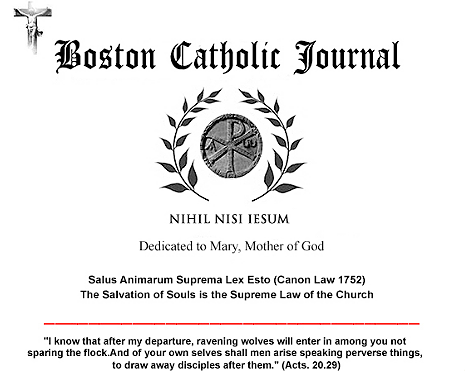|

The
Curious Faces of Sin

What Was Our Place in the Crucifying
of Christ?
The faces of sin, of course, are many
Anger, greed,
lust, pride —
we have seen, stood
before, the menacing faces of sin and we instinctively recognize them
despite all efforts to conceal or disguise the malice they portend.
They contort and disfigure the face that leers at us, the face behind
which the turbulence of sin implacably roils. We recoil from them in
either fear or disgust — and we abhor them. The signature of sin is
the same even as the faces change, but it is always inscribed on distinguishable
faces, on identifiable persons. The sin, the malice, is personal — that
is to say, it infects a personality, an individual to whom we have some
manifest connection. In a sense the malice, the evil, is personified;
it assumes the personality of another. Avoid the person and avoid the
malice, a very reasonable and effective remedy — for us as individuals.
There
is, however, another and much less clearly defined (but no less pernicious)
aspect of sin that we are far less disposed to recognize — despite ample
and apparently futile lessons from history.
Our Silence: the Sin of Omission
While
most of us grasp the existence of our own individual sins — and even
more clearly the sins of others — there is little awareness of our own
complicity in sins that lacerate us as a people, a society, a nation
— even a civilization. This absence of the realization of an evil to
which we contribute beyond our individual culpability, this failure
to recognize the reality of collective as well as personal sin – essentially
a recognition of our complicity in appalling moral enormities — not
through our acts but through our silence — is just as grave in nature
(but more far-reaching and devastating in consequences) than most of
our personal sins. The sin, as we see it, is not our own. It is not
of our making. We do not will it, therefore we are not responsible for
it. We recognize the evil. We lament it. But in the end, because we
do not enact the evil ourselves, we have no responsibility for it.
Now, multiply that by a society, a nation, a civilization, and we begin
to understand the nature of collective sin, the sin for which all are
responsible but in which no one personally participates ... It might
be summed up in three words: “Let it pass. Whatever the evil, whatever
the injustice, whatever the oppression — in whatever form it takes —“let
it pass.”
We
do not see — it is inconvenient to see — that when we fail to raise
our voice against evil, to stamp it out as inimical to the good, as
irreconcilably contrary to a Law greater than any men legislate (and
subsequently amend, discard, or abolish) in courts or seats of legislature,
however august, esteemed, and established its venue. Whenever we fail
to raise our voice, and simply “let it pass” —we have entered into complicity
with that outrage through our silence. We fear to condemn it, to reveal
our abhorrence of it ... to act against it ... and in remaining silent
we promote it. It is the sin of omission.
Unlike
individual sin which both confronts us and indicts us in clear and personal
terms, collective sin is a much more subtle evil that attempts to elude
the responsibility of the individual by diffusing and propagating itself
in a social context. It is collaborative sin, sin that is only possible
through the collaboration of the many. The Holocaust, slavery, and pornography
come immediately to mind. And because it is so subtle it is extremely
pervasive. In fact, we come to believe that the more pervasive it is,
the less evil it must be. It is essentially morality as distributive,
or more simply, morals as mathematics. In effect, “it is legitimized;
it has become a matter of open policy, and since a majority are either
practicing or condoning it, I myself cannot conceivably be held responsible
for it, even if I loathe it. In fact, I have no right to personally
object to what is publicly acceptable, and moreover, no legal recourse,
should I choose to. So ... I let it pass.”
We
may recognize the evil, but believe that we can abstract ourselves from
it and place the fault, the responsibility upon others. We distribute
the blame, the guilt, until it becomes so suffuse that it is no longer
morally tangible. That failing, any residual guilt can simply be ascribed
to some impersonal corporate body, to the vast number — of which we,
in fact, are part. This amorphous corporate body populated by real but
somehow anonymous persons, becomes our scapegoat when the core meltdown
of moral imperatives reaches critical mass and can no longer be ignored
without catastrophic consequences to the individual and society at large.
We
would do extremely well to reflect deeply upon the consequences of articulating
morality through numbers.
“Let it pass ...”
In
Mel Gibson’s, The Passion of the Christ, a very brief, but memorable
moment occurs when, amid the violence of the mob, an old woman stands,
looking quizzically upon the scene of personal carnage. She looks with
detachment, indifference, neither incited nor perturbed. This is such
a frightening vignette that encapsulates our moral indifference in the
face of evil. Her indifference, coupled with her curiosity, makes her
the metaphor of evil through omission, of complicity through indifference.
In this sense, she is a more frightening figure than the soldiers.
“Let
it pass ... what has it to do with me?”
Unknown
to her ... everything, both in time and in eternity.
Collective
sin is malice through mathematics; and because it is rooted in exponential
numbers, it is inherently cumulative. So much so, in fact, that the
individual sense of responsibility is diminished by the same exponent
through which the collective sin is multiplied. There is a clearly inverse
proportion between the magnitude of the distributed number and diminished
responsibility.
What,
then, was your place, my place, in the crucifying of Christ? What is
our place and what our responsibility in the starving of a child, in
the “therapeutic” killing of a baby in the womb, of the little girl
sold into the slavery of prostitution and pornography?
Meditating
on the Passion, how easily we abhor the weakness, the conspiracy of
the crowd — failing to see that we persecute Christ in our brother,
our sister before us ... with the same malice that motivated the Immolation
of the Lamb ... when we ourselves are the wolves ..
Do
you still think that you can take refuge in numbers, loose yourself
in the crowd? And how long will you continue “to let is pass” — until
it comes to your own doorstep?
Editor
Boston Catholic Journal
 Printable PDF Version
Printable PDF Version
Comments? Write us:
editor@boston-catholic-journal.com

Totally
Faithful to the Sacred Deposit of Faith entrusted
to the Holy See in Rome
“Scio
opera tua ... quia modicum habes virtutem, et servasti verbum
Meum, nec non negasti Nomen Meum”
“I
know your works ... that you have but little power, and
yet you have kept My word, and have not denied My Name.”
(Apocalypse 3.8)
Copyright © 2004 - 2025 Boston
Catholic Journal. All rights reserved. Unless otherwise
stated, permission is granted by the Boston Catholic Journal
for the copying and distribution of the articles and audio
files under the following conditions: No additions,
deletions, or changes are to be made to the text or audio
files in any way, and the copies may not be sold for a profit.
In the reproduction, in any format of any image, graphic,
text, or audio file, attribution must be given to the Boston
Catholic Journal.
|
|